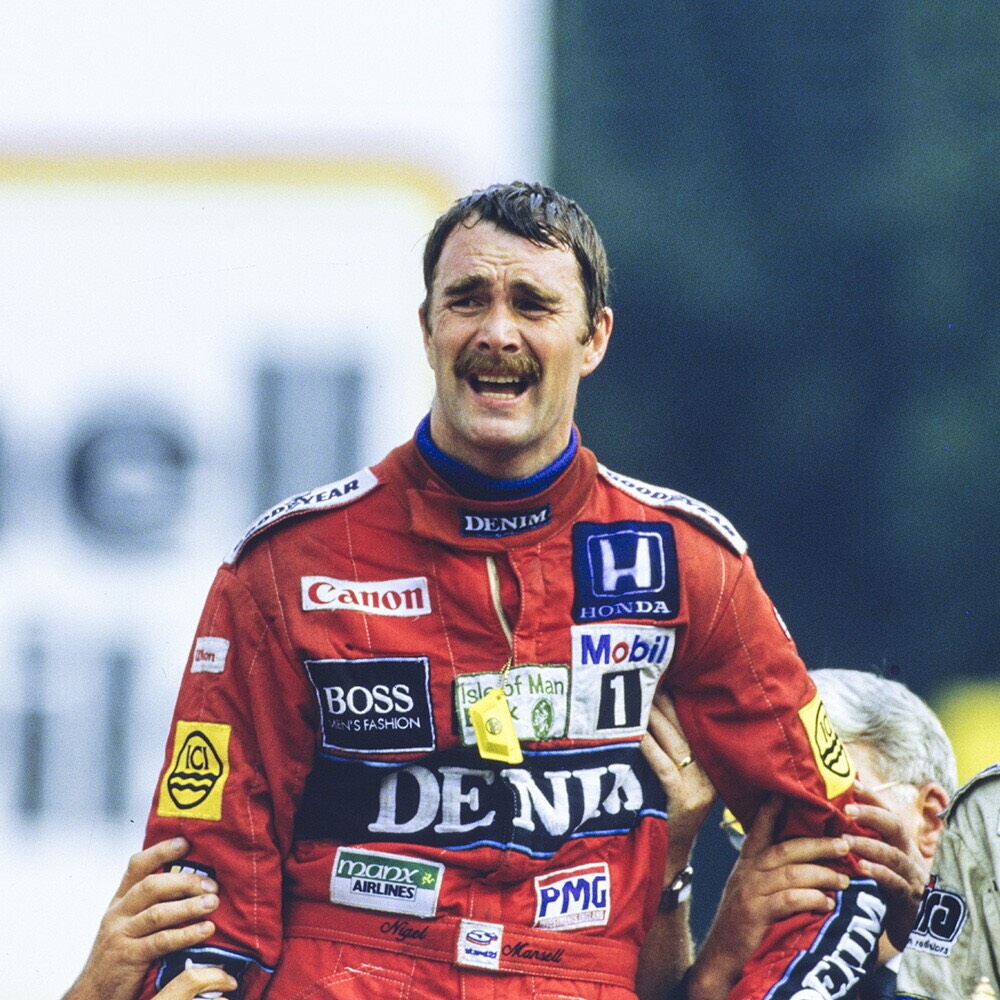
Nigel Mansell
World Championships
1992
Career Statistics
Biography
Nigel Ernest James Mansell (born 8 August 1953) is a British racing driver who competed in Formula One from 1980 to 1995, remembered as "Our Nige" by legions of British fans who followed his combative, never-say-die driving style that brought him the 1992 World Drivers' Championship in one of the sport's most dominant seasons, 31 Grand Prix victories, and a record-breaking move to American IndyCar racing where he became the only driver ever to hold both the Formula One World Championship and the IndyCar championship simultaneously, while his trademark bushy mustache, bulldog determination, and spectacular crashes earned him both "Il Leone" (The Lion) from Ferrari's tifosi and a reputation as one of Britain's most beloved sporting heroes.
Born near Birmingham, England, Mansell first drove a car at age seven and watched Jim Clark win the 1962 British Grand Prix at Aintree, deciding then to emulate the great Scot. His path to Formula One was extraordinarily difficult—after success in kart racing, Mansell became the 1977 British Formula Ford champion despite suffering a broken neck in a testing accident. Doctors told him he would never drive again, but Mansell sneaked out of hospital and raced on, demonstrating the stubborn determination that would define his career. Financial struggles plagued his junior career—he worked as an aerospace engineer to fund his racing, sold his house to finance his progression through the categories, and faced constant rejection before finally securing a Formula One test with Lotus in 1980.
Team principal Colin Chapman recognized Mansell's raw talent and gave him his debut at the 1980 Austrian Grand Prix, beginning a 15-season Formula One career that would span multiple teams and continents. Mansell's early years with Lotus (1980-1984) were characterized by spectacular speed in qualifying but chronic unreliability in races—mechanical failures robbed him of countless strong finishes, earning him a reputation as fast but unlucky. His maiden Formula One victory came at the 1985 European Grand Prix at Brands Hatch after 72 race starts, a breakthrough that validated his persistence and demonstrated his genuine race-winning ability. The following race at South Africa brought his second victory, establishing him as a consistent front-runner.
For 1985-1988, Mansell drove for Williams alongside Nelson Piquet, and their relationship was toxic—both drivers fought for team leadership, championships, and number-one status, creating internal warfare that often benefited rival teams. Despite the tensions, Mansell won multiple races and challenged for the championship, finishing runner-up in 1986 when a tire blowout at Adelaide cost him the title on the final lap. After two difficult seasons with Ferrari (1989-1990) where he was adored by the tifosi who nicknamed him "Il Leone" for his aggressive, attacking style and iconic mustache, Mansell returned to Williams for 1991 with designer Adrian Newey's revolutionary active suspension FW14. The 1991 season saw Mansell win five races and push Ayrton Senna's McLaren hard, finishing runner-up in the championship—his fourth second-place finish in the championship, a frustrating pattern that had defined his career.
Everything changed in 1992. Driving the Williams-Renault FW14B—arguably the most dominant Formula One car ever built, featuring active suspension, traction control, and a semi-automatic gearbox—Mansell annihilated the competition in the most dominant championship campaign in decades. He started the season with five consecutive victories (South Africa, Mexico, Brazil, Spain, San Marino)—a record that stood until Michael Schumacher matched it in 2004. He won nine of the season's first ten races, secured the World Drivers' Championship with five rounds remaining at the Hungarian Grand Prix, and finished the season with 9 victories, 14 pole positions (from 16 races), 8 fastest laps, and 108 championship points—a 52-point margin over teammate Riccardo Patrese that stood as the largest championship winning margin for over two decades.
The 1992 title made Mansell a British sporting icon, ending a 16-year drought since James Hunt's 1976 championship. However, Williams' decision to sign Alain Prost for 1993—giving the Frenchman number-one status and forcing Mansell to accept a secondary role—led to an acrimonious departure. Rather than accept diminished status, Mansell made the shocking decision to leave Formula One at the peak of his powers and join Newman/Haas Racing in American CART IndyCar racing. What followed was unprecedented: in his 1993 IndyCar rookie season, Mansell won five races and claimed the PPG IndyCar World Series championship, becoming the first and only driver in history to simultaneously hold both the Formula One World Drivers' Championship and the American open-wheel national championship.
His success in America, driving on unfamiliar oval circuits and against drivers who'd spent their entire careers mastering IndyCar's unique challenges, proved his adaptability and raw talent transcended categories. Mansell returned to Formula One for four races in 1994 with Williams (winning the season-finale Australian Grand Prix) and drove for McLaren in 1995, but his competitive fire had dimmed and he retired permanently at age 41. Over his F1 career, Mansell competed in 187 Grands Prix, winning 31 races, achieving 32 pole positions, 30 fastest laps, and 59 podium finishes—statistics that place him among Britain's greatest Formula One drivers alongside Jim Clark, Jackie Stewart, and Lewis Hamilton.
Nigel Mansell's legacy is that of a driver who refused to quit despite constant setbacks, financial hardship, and years of near-misses, whose aggressive, wheel-to-wheel racing style made him a fan favorite, whose 1992 championship represented one of Formula One's most dominant seasons, and whose move to IndyCar and immediate championship success proved his versatility and cemented his place as one of motorsport's most remarkable champions. His bushy mustache, combative personality, and never-give-up attitude made him "Our Nige" to millions of British fans and "Il Leone" to Ferrari's passionate supporters—a driver who embodied determination, speed, and the refusal to accept defeat.